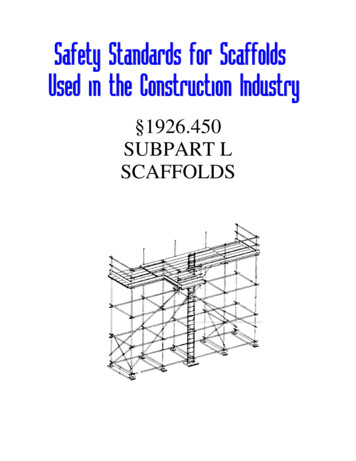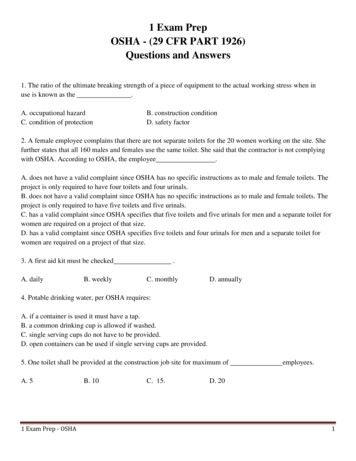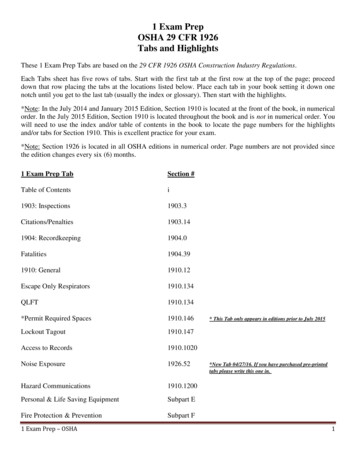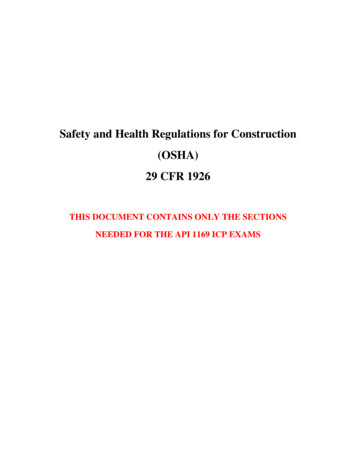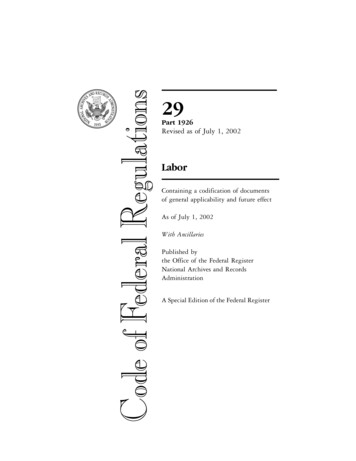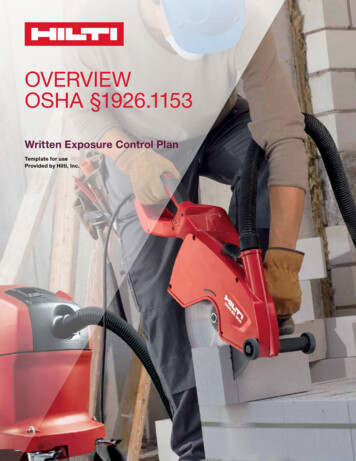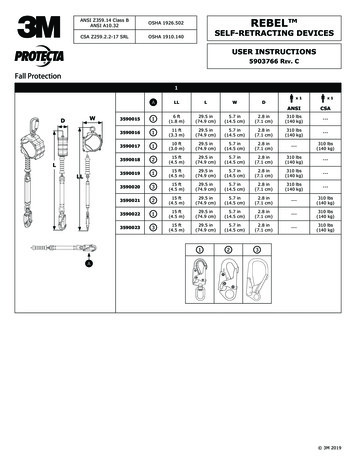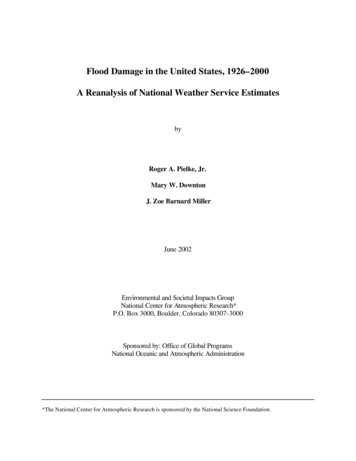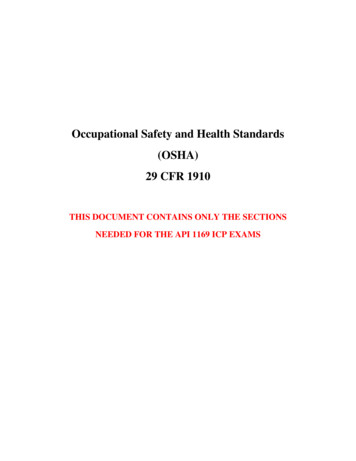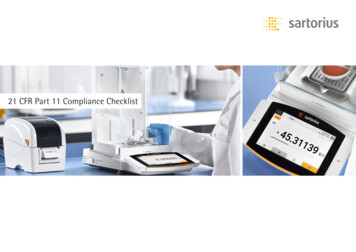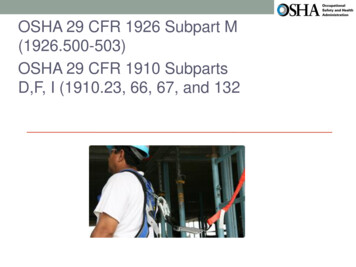
Transcription
OSHA 29 CFR 1926 Subpart M(1926.500-503)OSHA 29 CFR 1910 SubpartsD,F, I (1910.23, 66, 67, and 132
Importance of Fall Protection Each year, approximately 14 percentof fatal workplace injuries are causedby falls (Source: U.S. Dept. of Labor). In construction, approximately150-200 workers are killed annuallydue to falls (Source: OSHA).
Fall Protection RequirementsGeneral Industry (OSHA 1910) – must have in place if working at orabove four (4) feetMaritime (OSHA 1915) – must have in place if working at or abovefive (5) feetConstruction (OSHA 1926) – must have in place if working at orabove six (6) feet
Determining (Plan) Employer should determine if walking/working surfaceshave structuralstrength and integrity tosupport employees safely. Employer should verifyEmployees are allowed towork only on surfaceshaving strength and integrity.
Competent Person One who is capable of identifying existing andpredictable hazards in the surroundings or workingconditions, which are unsanitary, hazardous or dangerousto employees, and who has authorization to take promptcorrective measures to eliminate them.
Qualified Person One who, by possessionof a recognized degree,certificate or professionalstanding, or who by extensiveknowledge, training andexperience, has successfullydemonstrated ability to solveor resolve problems relatingto the subject matter, the workor the project.
Factors Affecting Total Fall Distance Length of connecting means (i.e., lanyard length, use of carabineers, snap hooks, etc.)Position and height of anchorage relative to workplatform/area (always keep above head wheneverpossible)Position of attachment and “D-ring” slide on full bodyharnessDeployment of shock absorber (max. 42”)Movement in lifelineInitial position of worker before free fall occurs
Types of Fall Protection Systems Articulating platforms provided with restraintsystems and full body harness to anchorpoint below waist Guardrails with toeboards Personal fall arrest systems:Anchor points (rated at 5,000 lbs.)Connectors (self-locking snap hooks)Retractable lanyardFull body harnessRestraint line-lanyardShock absorbing lanyardRope grabs
Types of Fall Protection Systems Engineered life lines Warning lines Safety nets Safety monitor systems
Recommended Locations forFall Protection All open excavations/pits All tasks requiring use of manlifts Scaffolding erection 10’ in height or greater Tuck-pointing/chimney repair Gymnasium (catwalks)
Recommended Locations forFall Protection All flat and low sloped roof locations when within 6’ ofroof edge or for repair/maintenance All exterior and interior platforms, catwalks,towers/antennas, etc. All exterior and interior ladders above 20 feet All mezzanine and balcony edges
Personal Fall Arrest Systems Full body harness used Should be inspected before each use by employee,looking for: Deteriorated areas Excessive wear Bent hooks/rings Evidence of impact/damage
Personal Fall Arrest Systems Connectors should be inspected to ensure they are drop-forged, pressed, formed steel or equivalent material. Connectors should have corrosion-resistant finish, andsurfaces/edges should be smooth. D-rings and snap hooks should have minimum tensilestrength of 5,000 lbs. and should be proof tested to 3,600lbs. Only shock absorbing or retractable lanyards should beused (keeps impact forces to the body at a minimum).
Personal Fall Arrest Systems Nylon rope or nylon straps with locking snap hooks usedfor restraints. Ensure unintentional disengagement of snap hookscannot happen by either: Checking to see if snap hooks are correct size for place they are tobe connected, or Snap hooks are of the locking type.
Personal Fall Arrest Systems Snap hooks should not be engaged as follows: Directly to webbing, rope, wire rope To each other To D-ring that has another snap hook attached To a horizontal lifeline Maximum free-fall distance not to exceed 6 feet. Consideration should be given to total fall distance.1926.502(d)(6)
Calculating Total Fall Distance Height of person Location distance of D-ring from work surface or platform Total length of shock absorbing lanyard Always allow minimum of 6 feet clearance above ground,equipment, etc., at end of fall from fall-arrest point!
Inspection of FallProtection Systems Inspect body harness before each use:Closely examine all nylon webbing for burn marks, tears,wear points, etc.Ensure no torn, frayed, broken fibers, pulled stitches,frayed edges anywhere on harness.Examine D-ring to ensure no pits, deterioration, cracks,excessive wear.Ensure buckles are not deformed/cracked and operatecorrectly
Inspection of Fall Protection Systems Body harness before each use:Ensure all grommets (if present) are secure and notdeformed from fall/abuse.Ensure harness has no additional punched holes.Ensure all rivets are tight and not deformed.Check tongue straps for excessive wear from repeatedbuckling.
Inspection of Fall Protection Systems Body harness:Annual inspection of harnesses should be completed bycompetent person.Annual inspection should be documented.Harnesses should be stored hanging in enclosed cabinetto protect from damage.Harnesses involved in fall should be destroyed.
Inspection of Fall Protection Systems Lanyards/shock absorbing lanyards, before each use:Check lanyard material for burns, cuts, rips, abrasions,kinks, knots, broken stitches, excessive wear.Ensure snaphooks are not distorted.Check carabineer for excessive wear, distortion, lockoperation.Ensure all locking mechanisms seat & lock properly.
Inspection of Fall Protection SystemsLanyards/shock absorbing lanyards, before each use: Once locked, locking mechanism should prevent hookfrom opening. Visually inspect shock absorber for signs of damage. Ensure points where lanyard attaches to snaphooks arefree of defects.
Inspection of Fall Protection Systems Lanyards/shock absorbing lanyards:Should be inspected annually by competent person.Annual inspection should be documented.Store lanyards/shock absorbing lanyards hanging inenclosed cabinet to prevent damage.Destroy all lanyards/shock absorbing lanyards involved ina fall.
Inspection of Fall Protection Systems Snaphooks, before each use:Look for hook and eye distortions.Verify that there are no cracks, eye distortions, pittedsurfaces.Ensure keeper latch is not bent, distorted, obstructed.Ensure keeper latch “seats” into “nose” without binding.Ensure keeper spring securely closes keeper latch.Test locking mechanism to verify it’s working properly.
Inspection of Fall Protection Systems Self-retracting lanyards, before each use:Visually inspect body to ensure no damage.Make sure all back nuts or rivets are tight.Make sure entire length of nylon strap is free from cuts,abrasions, burns, kinks, knots, etc.Test unit by pulling sharply on lanyard to verify lockingmechanism is working properly.Return to manufacturer for annual inspection, if requiredby manufacturer.
Inspection of Fall Protection SystemsSelf-retracting lanyards: Monthly inspection should be conducted by competentperson. Service per manufacturer’s recommendations. Inspect for proper function after every fall.
Inspection of Fall Protection SystemsTie-off adapters/anchorages: Inspect for integrity and attachment to solid surface. Annual inspection should be done by competent personand documented. Destroy and replace after fall.
Inspection of Fall Protection SystemsHorizontal lifelines: Before each use, check for structural integrity of line andanchors. Annual inspection should be completed by competentperson and documented.
Inspection of Fall Protection SystemsGuardrails: Temporary systems Daily visual inspection by competent person. Complete structural by competent person. Permanent systems Annual inspection by competent person. Frequency of future inspections based on conditions/controlspresent.
Storage & Maintenance of Fall ProtectionEquipment Never store in bottom of tool box, on ground or outside where exposed to elements.Hang equipment in cool, dry place in a way so it retains itsshape.Always follow manufacturer’s recommendation forinspection.Clean with mild, non-abrasive soap and hang to dry.Never “force dry;” allow to air dry.Never use strong detergents for cleaning.
Storage & Maintenance of Fall ProtectionEquipment Never store near excessive heat, chemicals, moisture or sunlight.Never store in an area where exposure to fumes orcorrosive elements may exist.Avoid dirt and build-up on equipment.Never use equipment for any other purpose other thanpersonal fall arrest.Once exposed to fall, remove equipment from serviceimmediately.
Engineered Lifeline Lifeline systems must be designed and approved by anengineer or qualified person. Lifeline systems must be engineered to have: Appropriate anchoragesStrength of line to hold X number of peopleLine strength to aid in arrest of fallDurability to hold fallen worker until rescued
Warning Line System Should be erected no less than 6 feet from edge of roof. Use stationary posts made of wood or metal. Should have wire or nylon rope and “caution flags” strungfrom post to post; must withstand 16 pounds of force. Entire perimeter of roof where work being performed mustbe guarded by warning line.
Floor & Wall Openings & Holes(OSHA 29CFR1910.23)Stairway Opening: Must be guarded by standard railing containing top rail,mid-rail, posts. Height: 42” from upper surface of top rail to floor/platform,etc. Top rail should be smooth-surfaced. Mid-rail should be halfway between top and floor/platform,etc. Railing on all exposed sides, except entrance to stairway.
Floor Openings & HolesLadder-way opening or platform: Must be guarded with standard railing and toeboard. Guarded on all exposed sides, except entrance toopening. Entrance to have swinging gate or an offset to preventdirect access.
Floor Openings & HolesHatchway & chute opening guarded by one of the following: Hinged floor opening cover of standard strength withstandard railings. Cover must be closed when not in use or exposed sideguarded with removable railings. Removable railing and toeboard on not more than twosides of opening. Fixed standard railings with toeboards on all otherexposed sides.
Floor Openings & HolesSkylight opening/hole: Must be guarded by standard skylight screen or fixedstandard railing on all exposed sides.Pit and trapdoor opening (if infrequently used): Must be guarded by standard strength and constructionfloor opening cover. When cover not in place, must be constantly attended orprotected on all exposed sides by removable standardrailings.
Floor Openings & HolesManhole opening: Must be guarded by standard manhole cover. Cover does not need to be hinged in place. When cover not in place, manhole must be constantlyattended or must be protected by removable standardrailings.Temporary floor opening: Must be guarded by standard railings or constantlyattended.
Wall Openings & HolesWall opening with drop of more than 4 feet (G.I.) or 6 feet(Const.)must be guarded by one of the following: General Industry requires either: Rail, Roller,Picket fence, Half door, or Equivalent barrier Construction requires either: Guardrail System, Safety netsystem, or Personal Fall Arrest System. If exposure below to falling materials, must haveremovable toeboard or equivalent.
Wall Openings & HolesChute openings with drop of 4 feet or more must beguarded by one of the following: Rail Roller Picket fence Half door Equivalent barrier
Powered Platforms, Manlifts,Vehicle-Mounted Work Platforms Employees on workingplatforms shall beprotected by apersonal fall arrest system. System must meetrequirements of OSHA 29 CFR1910.66, Appendix C, Section l.
Vehicle Mounted Elevating &Rotating Work Platforms Body belt should be worn and lanyard attached toboom or basket when working from an aerial lift.
Ramps, Runways, Other Walkways Employees must be protected from falling by guardrailsystems.
Training Employer must provide training to all affected employees. Suggested topics: Overview of related OSHA regulations. Nature of fall hazards in workplace. Correct procedures for assembling, maintaining,disassembling and inspecting fall protectionequipment to be used. Use and operation of guardrail, personal fallarrest, safety net, warning line and safetymonitor systems, as well as other protectionused.
Training Record Employers should maintain written certification trainingrecords for affected employees. Record should contain at least: Topic of training provided. Name or other identity of employee trained. Date(s) of training. Name (and signature recommended) ofinstructor who provided training.
Remember: Plan, Provide, and Train Provide fall protection when employees are workingabove 4’ in general industry, 5’ in Shipyards, or 6’ inconstruction. Fall protection should be a priority: safe actions savelives!
Questions
OSHA 29 CFR 1926 Subpart M (1926.500-503) OSHA 29 CFR 1910 Subparts D,F, I (1910.23, 66, 67, and 132 . Importance of Fall Protection Each year, approximately 14 percent of fatal workplace injuries are caused by falls (Source: U.S. Dept. of Labor). In construction, approximately 150-200 workers are killed annually due to falls (Source: OSHA). Fall Protection Requirements General
